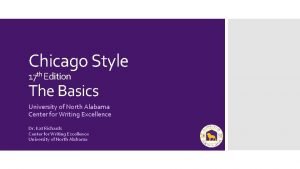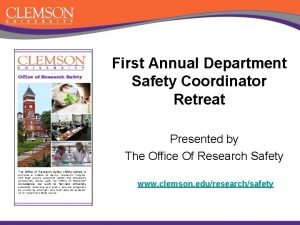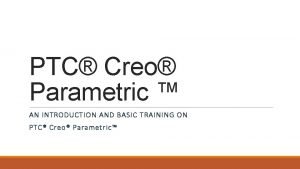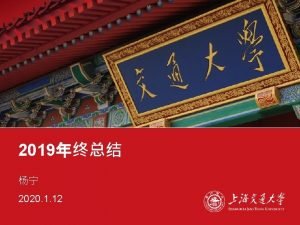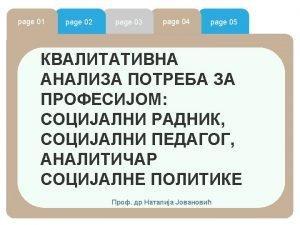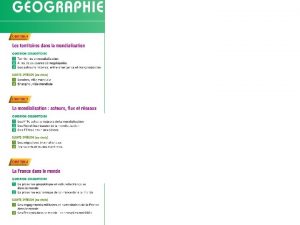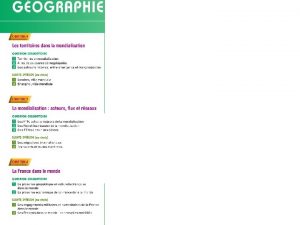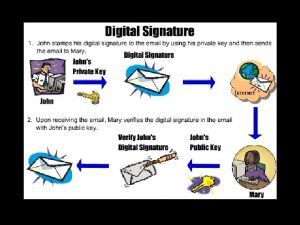Top Training Techniques Top Training Techniques Tool Page








- Slides: 8

Top Training Techniques

Top Training Techniques Tool– Page 1 “Executive Fly-By” Emerging Practice Cure: Have execs stay for part or all of the training. By all means, schedule executive(s) into speaking time slots. But, make sure they are involved in more than just a 60 -minute rah. Getting your sales force together for a training event can be Have them participate in training sessions as a learner. Or, expensive. Many companies opt to do so during Sales Kick Off. have them actually be guest instructors on a portion of the Having your sales reps in one place is a great opportunity to training. Have them work the exercises alongside the sales encourage them. Having company executives speak at these personnel. Put them on a panel for a question and answer session. events is a must-do. It is part of managing the change of Ensure they have some unstructured timeframes (dinners, culture: high-level communication and visible commitment. fun events, happy hours). This is where they will mingle with the sales force informally. They'll be able to hear perspective However, many executive(s) fly in for a 1 hour keynote and not always heard in the halls of the C-suite. We assume that then split. This runs the risk of demoralizing the team or setting a bad precedent. The sales force sees lip service only. the CSO or CRO will be present most of the time. The sales crew gets to see leadership "walking the walk" from day one. They then think it's not so important, or "it will pass". They don't commit, but use the event instead as a "vacation" from Recommendation: For 4 days of training, the executive(s) daily work. should plan on 1 day minimum. This can be a half-day afternoon, overnight, and a half-day morning. Plan to debrief with the executive(s) for their improvement suggestions.

Top Training Techniques Tool– Page 2 “Off-the-shelf Courseware” Emerging Practice Cure: Customization coupled with real-world pilot testing. The concepts are much more easily grasped when context is built in. For example, if instructing on negotiation skills, customized courseware uses the company's terminology. If This option is actually OK - if all you want is generic sales they use BAFO, BANT, BATNA, or all three, it is in the training. concepts for your sales force. With generic content, Reps might be able to apply it to their environments. They might Internal processes, titles, product/offering names, even have the time to do so. They might try to apply the concepts a names of leaders are in the customization. For sales process few times. If they fail, it's back to their comfortable methods. training, the steps are named what makes sense to that company. Sales manager training customization can refer They might all be trying to figure it out independently. They directly to the CRM dashboard name. All of this makes it more might even have time to share their successes with their familiar and friendly to the audience. But customization only fellow Reps. goes so far – you have to avoid “foreign instructors”. Recommendation: Customize not only content, but the What's missing from the generic concepts is the real world choice of modules to instruct. Use the "off menu" approach. context. The concepts are taught, but not totally grasped. This is what I do in a restaurant: I look to see what ingredients Why? They aren't wrapped in company-specific context. they have by reading all their entree descriptions. I then Sure, instructors can ask for company stories/scenarios and cobble together a meal using their available components. Do share these. But, this level of story does not become the same with your sales training provider. Ensure they have ingrained in the content. multiple components of training materials. Then pick those that your sales force needs most and have them customized.

Top Training Techniques Tool– Page 3 “Foreign Instructors” Emerging Practice Cure: Use your sales force as instructors. Leverage Sales Managers and Sales Reps to do the teaching. It may not be as polished as professional trainers, but it is more impactful. For one thing, they will have the context and real-life stories. This If you get your content customized with your context, don't makes the content come alive. Hopefully, you've had these follow with this mistake. Instructors that are not from your instructors piloting the materials before training day - a part company will also lack context. The instructor has not dealt of this emerging practice. This gives them the real-life stories with your sales force. They have not had to take the brunt of about how they applied concepts. The trainees get not only a Sales Manager's criticism. They haven't had to navigate your concepts with context, but how to apply them. company's internal sales processes. They have not fretted Recommendation: Choose a team of Reps + Sales Managers, about a shrinking pipeline. maybe even some sales directors/VPs. They should be So, they lack the logistical and emotional context that your assessed for training and storytelling capabilities. They don't sales force knows. We even go so far as to say company have to be perfect trainers. But, they'll need to be able to instructors not from sales are 'foreigners'. Sure, in both cases hold an audience's attention. Train the concepts to them in a the instructor may have shadowed a sales rep or manager. train-the-trainer manner. After this, set them off on a pilot to But that context is not as deep as a Rep agonizing over a lost use the concepts. During the pilot, they'll also provide deal. feedback on how to best customize/improve content. Again, part of this customization is the context they experience through the pilot. Ensure professional instructors or the OD team participates in training as backups or some other role.

Top Training Techniques Tool– Page 4 “Virtual-only Training” Emerging Practice Cure: Have a balance of virtual and in-person training. There is tremendous benefit in bringing sales personnel together, even if it is expensive. We’ve seen over and over a benefit accrue of best practices being shared and stronger We see some companies move to virtual-only training. The thought is to save the expense of flying everyone to one (or a relationships being formed. The in-person group togetherness also galvanizes teams so that they don’t feel few) locations. This can be a mistake. There are issues with virtually-led sessions including lack of attention. This may be isolated or alone with challenges. It also gives Corporate a chance to communicate messages to the sales force, get because of ‘multi-tasking’. Also, virtual training lacks the element of real-time audience feedback from them, have brainstorming sessions with them, feedback. Being in the room with people gives the instructor or even replace or update technology. Recommendation: Plan on having at least one in-person a feeling for how content is being received. This isn’t training event each year for the complete sales force. This completely possible via virtual-only training. can be tied to Sales Kickoff or separate. For large geographic The biggest downside to virtual-only is the missed regions, consider staging multi-regional events – which opportunity for sales personnel to come together. A lost reduces cost, but still allows for team building and best chance to build stronger relationships and share best practice sharing. Plan for more frequent virtual training – practices. To help each other work through challenges. which can be self-service AND live. When using virtual training, make video usage mandatory (reduces multi-tasking) or use software that monitors screen attention.

Top Training Techniques Tool– Page 5 “One-and-done Training Event” Emerging Practice Cure: Implement training event pre-work and post-event reinforcement. Send out invitations to the event with notice that pre-work will be required for the training event. Have frequent communications and even a Q&A session about it in Holding an in-person or virtual training event is a big undertaking. But from the trainee perspective, they may not the weeks before the event. Leverage the pre-work within the perceive value in it. They feel it is an interruption. They don’t training event. After the event, make sure there will be frequent ‘reinforcement’ sessions. These can be virtual. They feel connected to the training. They show up and wonder will take the concepts from the in-person training event and what relevance the training will have for them. They sit break them down into weekly/bi-weekly/monthly digestible through the 1 to 5 days of training, get a printed manual or electronic document of the materials. Yeah, it was great being chunks. with all of their colleagues for a few days. But now their best Recommendation: Lay out the training calendar by starting intentions to use the concepts are lost back in the daily grind. with the in-person event date, then backing up to provide enough time for participant pre-work. Ensure the training The weeks roll by and they pick up the materials again, but materials are related to the pre-work and will leverage use of forget how the tools should be used. They can’t find the pre-work in the event (whether during lecture or handsanswer in the materials and don’t have time to contact on exercises. ) After the event, lay out a calendar of frequent someone for help. So, they set it aside hoping to get to it sometime in the future. They wonder if anyone else is using reinforcement sessions. Include preparation and post-session action items. Make sure the action items are measureable these concepts for gain. and drive the desired behaviors as learned in the training event. Consider gamifying the pre-work, event, and post-

Top Training Techniques Tool– Page 6 “Lecture-heavy content” Emerging Practice Cure: Carefully plan a sufficient variety of exercises within training. Exercises should leverage real-world scenarios – ones that were encountered during the piloting of the concepts by the Lecture-heavy refers to instructional material that has less instruction team. The types of exercises should not be than 3 exercises in an 8 -hour day of training. It also is content same kinds over and over. Instead, prepare a variety of that leans more toward concept than including stories and exercises that includes role-plays, scenario + essay, live-fire scenarios (context). This sort of content is also not well exercises (where teams brainstorm a real sales challenge), adopted after the training. using a learned tool within an exercise. For example, if one tool is for grading a social profile, actually use this tool within Whether in-person or virtual, training that is lecture-heavy an exercise to bring the content home. Content should also will have low success rates. Even with stories and scenarios include rich media, not just slide-uments. (which help in the grasping of concepts), the learners won’t Recommendation: Gamification works well for exercises. Set get as much out of it without exercises. Having to sit through up your ‘game’ to reward for exercise participation and non-professional instructors (you ARE using your sales force results. When designing the courseware, ensure enough as instructors, correct? ) ramble on causes participants to exercises are set for each day of training – at least 3 per day. check out. The exercises can be as short as 10 minutes or as long as a couple hours. If possible, start the training session with a true exercise on the concepts (not just an icebreaker. ) Try to get participants mingling through exercises that call for changing teams or partners. Use on-hand executives in exercises.

Top Training Techniques Tool– Page 7 “Ignoring the CRM component” Training materials may be great at teaching sales personnel about concepts. It helps them to be better sales reps or managers with sales skills. However, the CRM or Sales Force Automation tools are integral to an effective sales force. Not integrating learning with CRM pieces does 2 things: 1) reduces the importance your company has on CRM usage; 2) causes Sales personnel to stumble after training when trying to marry concepts with daily sales life. For example, let’s say a training concept teaches Sales Reps about a new concept like the buyer’s process. However, the training did NOT include how the buyer’s process is embedded in the CRM. When the Rep tries to enter an opportunity at the right buyer stage, they can’t figure out how it works in the CRM. Emerging Practice Cure: Instruct on how the CRM will use taught concepts. Either add a separate module of training that brings everyone through CRM integration of the concepts or ensure a piece of each training module talks about CRM usage. This will help Sales personnel better assimilate concepts (because they have to use them in a practical manner). Also, it gives the instruction team a chance to see who needs additional CRM training and of what sort. Recommendation: Consider demanding that all participants have their computer at training events. Design content that walks learners through a scenario that moves from real life to the necessary CRM tasks. Have participants go through exercises that puts them into the CRM. You’ll probably want to set up a training area of your CRM, or at least have everyone use a naming convention that makes it easy to erase this false ‘training’ content at a later time.


